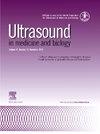Low-Intensity Pulsed Ultrasound Dynamically Modulates the Migration of BV2 Microglia
IF 2.4
3区 医学
Q2 ACOUSTICS
引用次数: 0
Abstract
Objective
Low-intensity pulsed ultrasound (LIPUS) is a promising modality for neuromodulation. Microglia are the resident immune cells in the brain and their mobility is critical for maintaining brain homeostasis and alleviating neuroimmune pathologies. However, it is unclear whether and how LIPUS modulates microglial migration in physiological conditions.
Methods
Here we examined the in vitro effects of LIPUS on the mobility of BV2 microglia by live cell imaging. Single-cell tracing of BV2 microglia migration was analyzed using ImageJ and Chemotaxis and Migration Tool software. Pharmacological manipulation was performed to determine the key molecular players involved in regulating ultrasound-dependent microglia migration.
Results
We found that the distance of microglial migration was enhanced by LIPUS with increasing acoustic pressure. Removing the extracellular Ca2+ influx or depletion of intracellular Ca2+ stores suppressed ultrasound-enhanced BV2 migration. Furthermore, we found that blocking the reorganization of actin, or suppressing purinergic signaling by application of apyrase or hemi-channel inhibitors, both diminished ultrasound-induced BV2 migration. LIPUS stimulation also enhanced microglial migration in a lipopolysaccharide (LPS)-induced inflammatory environment.
Conclusion
LIPUS promoted microglia migration in both physiological and inflammatory environments. Calcium, cytoskeleton, and purinergic signaling were involved in regulating ultrasound-dependent microglial mobility. Our study reveals the biomechanical impact of ultrasound on microglial migration and highlights the potential of using ultrasound-based tools for modulation of microglial function.
低强度脉冲超声动态调节BV2小胶质细胞的迁移。
目的:低强度脉冲超声(LIPUS)是一种很有前途的神经调节方式。小胶质细胞是大脑中的常驻免疫细胞,其移动性对维持大脑稳态和减轻神经免疫病变至关重要。然而,LIPUS是否以及如何调节生理条件下的小胶质细胞迁移尚不清楚。方法:采用活细胞显像法检测LIPUS对BV2小胶质细胞移动性的体外影响。利用ImageJ和Chemotaxis and migration Tool软件分析BV2小胶质细胞迁移的单细胞示踪。进行药理学操作以确定参与调节超声依赖性小胶质细胞迁移的关键分子。结果:小胶质细胞的迁移距离随着声压的增加而增加。去除细胞外Ca2+内流或细胞内Ca2+储存的消耗抑制超声增强的BV2迁移。此外,我们发现通过应用apyrase或半通道抑制剂阻断肌动蛋白重组或抑制嘌呤能信号传导,都可以减少超声诱导的BV2迁移。LIPUS刺激还能在脂多糖(LPS)诱导的炎症环境中增强小胶质细胞的迁移。结论:LIPUS促进了小胶质细胞在生理和炎症环境下的迁移。钙、细胞骨架和嘌呤能信号参与调节超声依赖性小胶质细胞的移动。我们的研究揭示了超声对小胶质细胞迁移的生物力学影响,并强调了使用基于超声的工具调节小胶质细胞功能的潜力。
本文章由计算机程序翻译,如有差异,请以英文原文为准。
求助全文
约1分钟内获得全文
求助全文
来源期刊
CiteScore
6.20
自引率
6.90%
发文量
325
审稿时长
70 days
期刊介绍:
Ultrasound in Medicine and Biology is the official journal of the World Federation for Ultrasound in Medicine and Biology. The journal publishes original contributions that demonstrate a novel application of an existing ultrasound technology in clinical diagnostic, interventional and therapeutic applications, new and improved clinical techniques, the physics, engineering and technology of ultrasound in medicine and biology, and the interactions between ultrasound and biological systems, including bioeffects. Papers that simply utilize standard diagnostic ultrasound as a measuring tool will be considered out of scope. Extended critical reviews of subjects of contemporary interest in the field are also published, in addition to occasional editorial articles, clinical and technical notes, book reviews, letters to the editor and a calendar of forthcoming meetings. It is the aim of the journal fully to meet the information and publication requirements of the clinicians, scientists, engineers and other professionals who constitute the biomedical ultrasonic community.

 求助内容:
求助内容: 应助结果提醒方式:
应助结果提醒方式:


